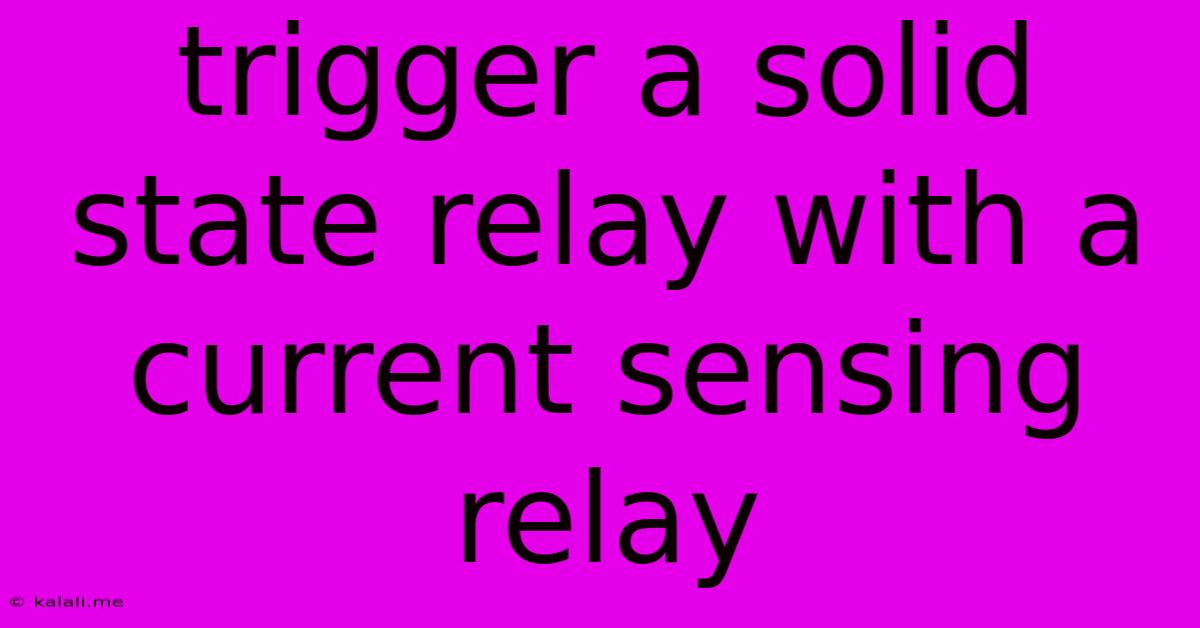Trigger A Solid State Relay With A Current Sensing Relay
Kalali
May 30, 2025 · 4 min read

Table of Contents
Triggering a Solid State Relay (SSR) with a Current Sensing Relay: A Comprehensive Guide
This article explores the practical application of using a current sensing relay to trigger a solid-state relay (SSR). We'll delve into the principles, advantages, and considerations involved in this configuration, providing a comprehensive guide for both beginners and experienced electronics enthusiasts. Understanding this setup is crucial for building reliable and efficient automated control systems.
What is a Solid State Relay (SSR)?
A solid-state relay (SSR) is a semiconductor device that switches electrical power using an electronic signal instead of mechanical contacts. This eliminates the wear and tear associated with mechanical relays, leading to a longer lifespan and improved reliability. SSRs are ideal for applications requiring high switching speeds and a long operational life. They are frequently used in controlling AC loads like motors, heaters, and lighting.
What is a Current Sensing Relay?
A current sensing relay is a specialized relay that monitors the current flowing through a circuit. When the current exceeds a predefined threshold, the relay activates, closing its contacts and triggering a connected circuit. This makes it perfect for overload protection, motor monitoring, and other applications where current levels are critical.
Why Combine a Current Sensing Relay and an SSR?
Combining a current sensing relay and an SSR creates a robust and efficient control system with several advantages:
-
Overload Protection: The current sensing relay acts as a safety mechanism. If the load connected to the SSR draws excessive current (e.g., due to a short circuit or overload), the current sensing relay will immediately trip, disconnecting the load and preventing damage to the SSR or other components. This is crucial for protecting expensive equipment and preventing safety hazards.
-
Precise Control: The SSR provides precise and fast switching of the load, while the current sensing relay ensures that the load operates within safe current limits.
-
Increased Reliability: The combination of a solid-state switch (SSR) and a protective relay significantly increases the overall system reliability compared to a system using only mechanical components.
How to Trigger an SSR with a Current Sensing Relay:
The setup is relatively straightforward. The current sensing relay needs to be wired in series with the load, monitoring the load current. When the current exceeds the set threshold, the current sensing relay closes its contacts, providing the control signal to the SSR. This triggers the SSR, turning on the connected load. If the current falls below the threshold, or if the current sensing relay trips due to an overload, the contacts open, turning off the SSR and the load.
Circuit Considerations:
-
Relay Selection: Choose an SSR with an appropriate voltage and current rating for your load. Similarly, the current sensing relay should have a current rating that matches or slightly exceeds the expected maximum load current. Consider the response time of both relays to ensure timely triggering.
-
Wiring: Correct wiring is critical. The current sensing relay must be in series with the load, while the SSR's control input is connected to the relay's output. Proper grounding is essential to ensure safe operation.
-
Load Characteristics: Understand the characteristics of your load, including its inrush current. The current sensing relay's threshold needs to be set accordingly to avoid false triggering.
-
Safety Precautions: Always observe safety precautions when working with electrical circuits. Ensure that the voltage and current ratings of all components are adequate and that proper insulation is used.
Applications:
This configuration finds applications in various scenarios, including:
-
Motor Control: Protecting motors from overload conditions by tripping the circuit if the current exceeds the motor's safe operating limit.
-
Heater Control: Preventing overheating by monitoring the current draw of the heating element.
-
Lighting Systems: Protecting lighting fixtures from damage due to overcurrent.
-
Industrial Automation: Implementing safety measures in automated processes by monitoring current levels in various equipment.
Conclusion:
Triggering an SSR with a current sensing relay offers a reliable and efficient solution for controlling AC loads while providing crucial overload protection. By carefully selecting components and understanding the circuit's operation, you can build a robust and safe control system for a wide range of applications. Remember to prioritize safety and proper component selection for optimal performance and longevity.
Latest Posts
Latest Posts
-
How To Clean A Rusty Grill
May 31, 2025
-
Refrigerator Not Cooling But Freezer Works
May 31, 2025
-
How Do You Turn Off Amber Alerts On Android
May 31, 2025
-
How To Make A Generator Stronger
May 31, 2025
-
How To Remove Ceiling Light Cover
May 31, 2025
Related Post
Thank you for visiting our website which covers about Trigger A Solid State Relay With A Current Sensing Relay . We hope the information provided has been useful to you. Feel free to contact us if you have any questions or need further assistance. See you next time and don't miss to bookmark.